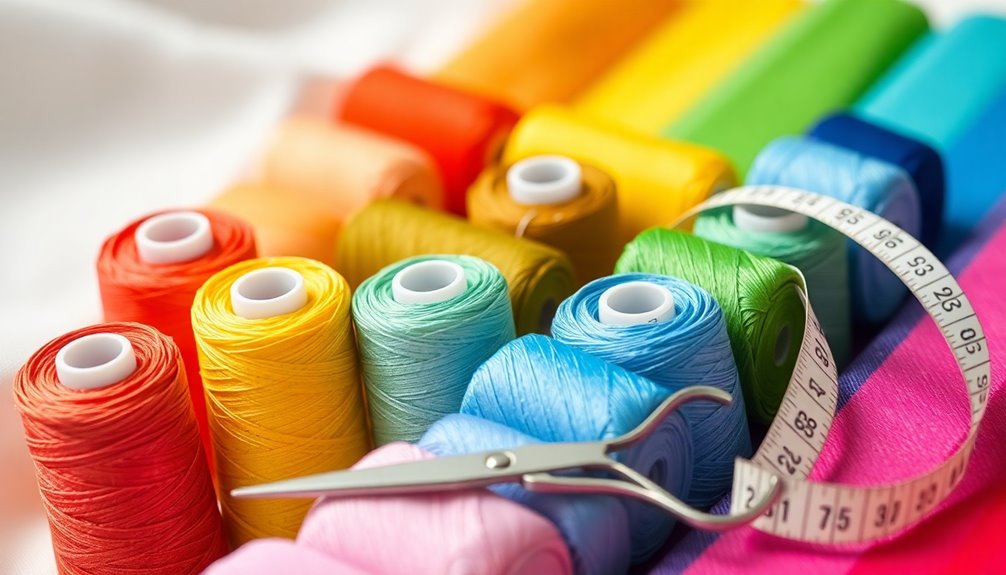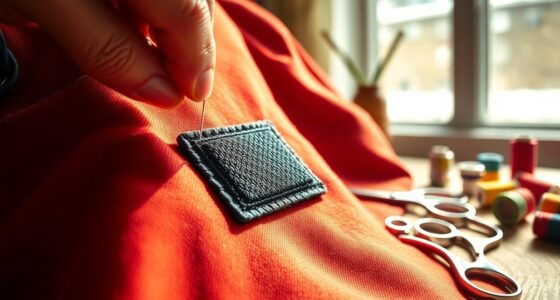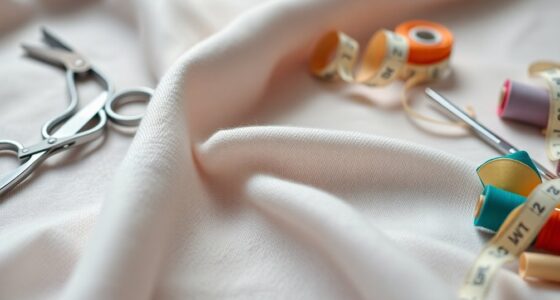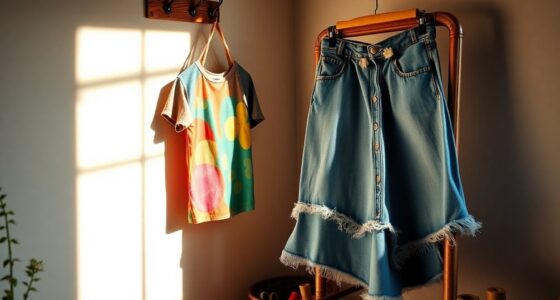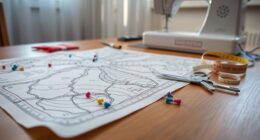To revolutionize your sewing, grasping thread weight is key! It impacts everything from stitch quality to fabric compatibility. Remember, smaller numbers mean heavier threads; for example, a 40 wt is a great choice for most projects. Pair it with the right needle size and tension settings to avoid common thread problems like breakage and looping. Armed with our ultimate thread weight chart, you can elevate your sewing game. Stick around to discover more tips for success!
Key Takeaways
- A comprehensive thread weight chart helps you easily identify suitable thread types for various fabrics and sewing projects.
- Understanding thread weight conversions ensures accurate matching of thread to needle and fabric, improving stitch quality.
- Using the right thread weight enhances your embroidery designs, providing better coverage and clarity in your work.
- Regularly adjusting tension settings based on thread weight prevents common issues like thread breakage and looping during sewing.
- Proper thread maintenance and care, guided by a weight chart, prolongs thread lifespan and optimizes sewing machine performance.
Understanding Thread Weight
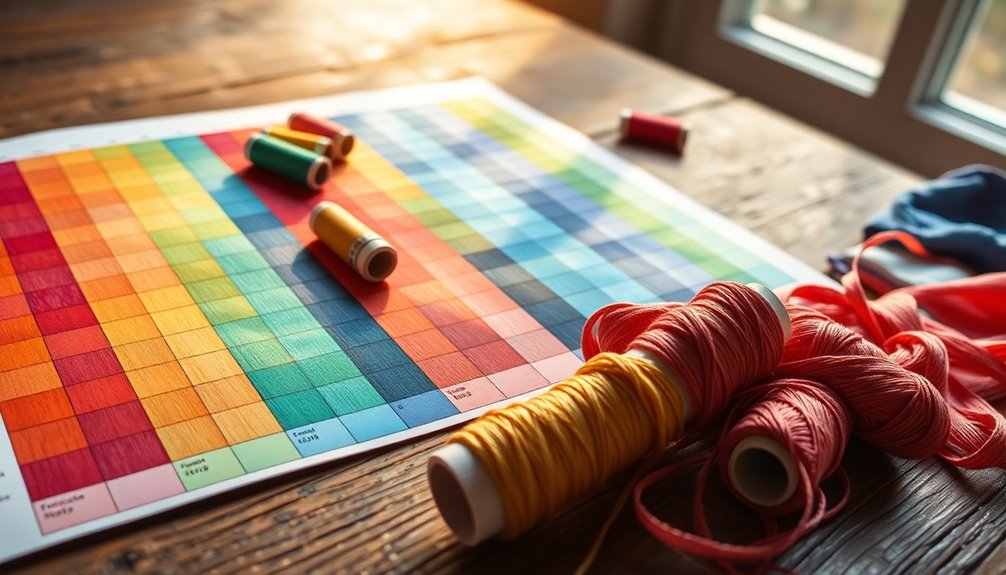
When you immerse yourself in the world of sewing, understanding thread weight becomes essential.
Thread weight indicates the thickness and density of the thread, with smaller numbers like 30 wt being heavier than 40 wt, which is commonly used for various sewing projects.
A 90/14 needle size is ideal for 40 wt cotton thread, preventing shredding and ensuring smooth stitching.
Knowing how to choose the right thread weight can elevate your embroidery design, providing maximum coverage.
If you need to switch between systems, a conversion chart can simplify things, helping you convert 40 wt to Tex (25) or Denier (225).
Types of Thread

Understanding the various types of thread is essential for achieving the best results in your sewing projects. Here's a quick overview of common threads and their applications:
| Thread Type | Best Used For | Key Features |
|---|---|---|
| Cotton | Quilting | Twisted fibers, strong |
| Polyester | All-purpose sewing | Durable, mimics cotton/silk |
| Rayon | Decorative stitching | High sheen, may weaken |
| Metallic | Embroidery | Delicate, needs special care |
Choosing the right thread weight and type will enhance your sewing applications. Cotton's strength is perfect for quilting, while polyester's durability makes it versatile. Rayon adds a beautiful finish, and metallic threads create stunning embellishments. Remember to take into account the unique properties of each thread!
Troubleshooting Your Thread Problems
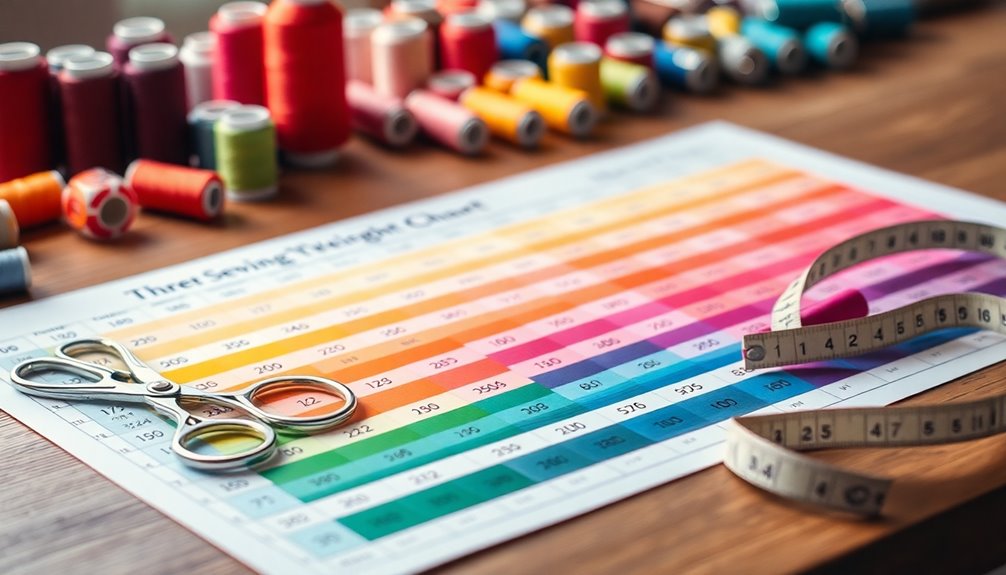
When you encounter thread problems, adjusting your needle size and tension settings is essential for achieving great stitch quality.
High or low tension can lead to issues like thread breakage or looping, so fine-tuning these settings based on your thread weight is key.
Keep an eye on your needle condition too, as a worn needle can also contribute to common stitch issues.
Adjusting Needle Size
Adjusting your needle size is essential if you're facing thread problems, especially with heavier threads like 30 wt. or 12 wt.
When using these thicker threads, choose a needle that's about 40% larger than the thread diameter—like a 90/14 needle for 40 wt. This larger eye helps prevent shredding or breakage during sewing.
To maintain stitch quality and avoid fabric damage, guarantee your needle size matches the thread weight. If you're still having issues, consider increasing the stitch length to accommodate the thicker diameter and prevent bunching.
Don't forget to regularly check your needle condition; a damaged needle can worsen problems with tension and stitch quality when working with various thread weights.
Tension Settings Explained
Since proper tension settings are essential for achieving flawless stitches, knowing how to adjust them can save you from frustrating thread issues. Here's what to take into account:
- Heavier threads often require a looser tension for ideal stitch quality.
- Lighter threads may need increased tension to prevent thread breakage.
- Regularly monitor tension settings based on the thread type you're using.
When switching thread weights, always adjust the tension to maintain stitch density. High tension can cause skipped stitches, while low tension can lead to uneven seams.
A smooth sewing experience hinges on your ability to effectively adjust the tension. By mastering this pivotal aspect, you can tackle any sewing project with confidence and skill.
Common Stitch Issues
To troubleshoot common stitch issues, it's essential to identify the root cause of the problem quickly. Stitch quality can suffer due to improper thread tension or incorrect needle size. For heavier threads, make certain you use a larger needle eye to avoid shredding. Remember, adjusting tension is key when switching between thread weights; too high can lead to breakage, while too low may create a loop on the back.
| Stitch Problem | Solution |
|---|---|
| Loop on the back | Adjust thread tension |
| Shredded thread | Use appropriate needle size |
| Inconsistent stitches | Match thread weight to design |
Most embroidery designs are for 40-weight thread, so adjust your settings accordingly for best results.
Thread Size Conversion Chart
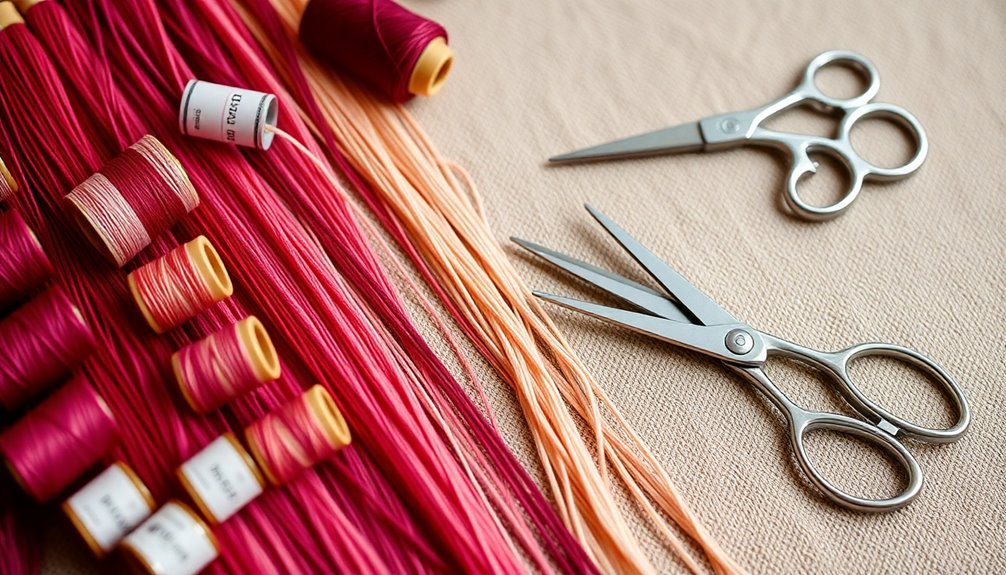
When you're choosing the right thread for your project, understanding thread size conversions is key.
You'll find that different measurement systems, like tex and denier, can seem complicated, but a conversion chart simplifies the process.
Let's explore some common thread types and how to easily switch between their sizes.
Conversion Basics Explained
Understanding thread size conversions can seem intimidating, but a thread size conversion chart simplifies the process by providing clear equivalents for various thread weights.
This chart helps you navigate the complexities of thread measurement, ensuring you select the right thread for your sewing projects.
Here are a few things to keep in mind:
- Different systems like Tex, Denier, and Number Metric (Nm)
- Quick conversions, such as 40 weight thread equals 40 Nm
- Enhanced efficiency for consistent sewing results
Common Thread Types
While selecting the right thread for your project, it's essential to know the common thread types and their corresponding weights.
The thread size conversion chart helps you compare different systems like Tex, Denier, and weight, ensuring accurate thread selection. You'll find light-weight threads range from Tex 8-25, medium-weight threads from Tex 25-40, and heavy-weight threads at Tex 40 and up.
For instance, a 40 weight thread matches Tex 25, 225 Denier, and 40 Nm. Understanding these categories prevents confusion, especially since brands vary in measurement systems.
Whether you're sewing with a poly/cotton blend or another fabric, knowing these common thread weights will streamline your sewing process and enhance your results.
Importance of Thread Weight
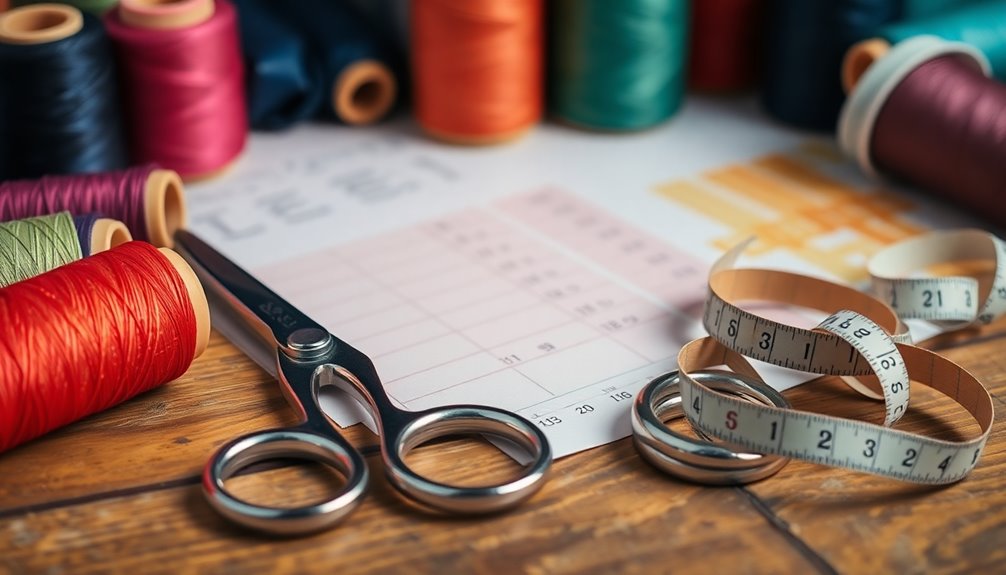
Thread weight plays an essential role in your sewing projects, as it directly impacts needle selection, tension, and the overall quality of your stitches.
Using the right thread weight guarantees:
- Ideal performance with appropriate needle size, usually 40% larger than the thread diameter for heavier threads.
- Enhanced stitch quality, avoiding issues like loops or skipped stitches in embroidery.
- Proper fabric compatibility, where lighter fabrics need finer threads and heavier fabrics can handle thicker threads.
Understanding the Tex measurement helps you choose the right thread weight, with larger Tex numbers indicating thicker threads.
Adjusting stitch density is significant too; heavier threads may require longer stitch lengths to maintain design clarity.
Mastering these elements assures your sewing projects turn out beautifully!
Shopping for Thread at WAWAK Sewing Supplies
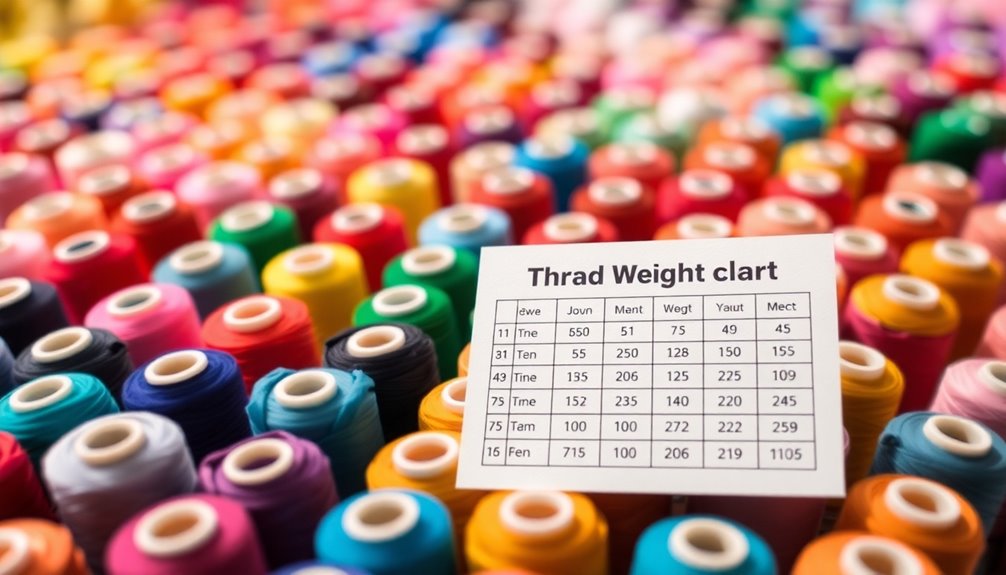
Selecting the right thread weight is just the beginning of your sewing journey. When you shop at WAWAK Sewing Supplies, you'll find an extensive selection of thread types, including high-quality cotton thread, polyester thread, and quilting thread.
Their user-friendly online store simplifies the process, allowing you to easily navigate through various thread weights and applications. With WAWAK's downloadable printable guides, understanding thread weight conversions becomes effortless, ensuring you choose the perfect match for your project.
Whether you're a hobbyist or a professional, WAWAK provides the resources you need to make informed decisions about your sewing supplies. Explore their offerings today and elevate your sewing experience with the right thread!
Frequently Asked Questions
What Is the Best Thread Weight for Sewing?
The best thread weight for sewing really depends on your project.
For most general sewing tasks, you'll want to use 50 wt. thread; it's versatile and works well for garments and quilting.
If you're embroidering, 40 wt. polyester is your go-to for durability.
For hand stitching, consider heavier threads like 12 wt. or 18 wt.
Remember to match your thread with the right needle size to achieve the best stitch quality!
Which Is Heavier, 30 or 40 Weight Thread?
When you're comparing 30 weight and 40 weight threads, 30 weight thread is heavier. The lower the number, the thicker the thread, so 30 weight has a denier of around 300, while 40 weight's denier is about 225.
If you choose to use 30 weight for your projects, you'll need to adjust your needle size and tension settings to guarantee your stitching quality remains high.
Don't forget to take into account your design requirements as well!
Is 40 Wt Thread Thicker Than 50 Wt?
Yes, 40 wt thread is thicker than 50 wt thread. The lower the number, the heavier and thicker the thread is.
So, when you're using 40 wt, you'll notice it provides more coverage and creates a denser stitch compared to 50 wt.
If you're switching between these weights, remember to adjust your needle size and tension to keep your stitch quality consistent. This guarantees your projects turn out just the way you want them!
What Is the Difference Between 30 Wt and 50 Wt Thread?
When you compare 30 wt and 50 wt thread, you'll notice that 30 wt is heavier and better for durable applications like quilting and decorative stitching.
It provides more texture but requires a larger needle, like 90/14.
In contrast, 50 wt is finer, perfect for general sewing and lightweight fabrics, typically using a needle size of 75/11 or 80/12.
Adjust your tension settings accordingly to guarantee great stitch quality with both thread types.
Conclusion
Now that you've unraveled the mystery of thread weight, you're ready to transform your sewing projects into masterpieces. Picture yourself gliding through fabrics, each stitch a vibrant thread in your creative tapestry. With the right thread, your sewing machine hums like a symphony, producing beautiful results that speak volumes. So, as you plunge into the world of WAWAK Sewing Supplies, let your imagination soar, and embrace the endless possibilities that await with every spool you choose.
